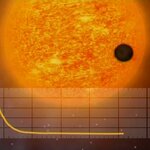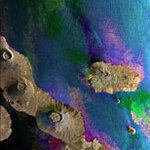Space

We had an exciting two hours back when the STEREO solar telescope satellites were first launched. The first summed image of several hours of first-light data showed a clear distortion in one of the ten SECCHI detectors. Doom! Tragedy! Can we compensate for it?
It was almost like the sky was a bathtub draining to the lower left. All the light warped and bended in that direction. Opinions varied as to the cause... was it a bad CCD, misalignment of the scope, or satellite pointing issue? Was that detector totally FUBARed? Could it be saved!?!?!
Mundanely, a programmer reran the data with better…

An unusual spiral galaxy in the Coma galaxy cluster has been imaged using data obtained by the Advanced Camera for Surveys on the Hubble Space Telescope. It reveals fine details of the galaxy, NGC 4921, and an extraordinary rich background of more remote galaxies stretching back to the early Universe. The Coma galaxy cluster, in the northern constellation of Coma Berenices, the hair of Queen Berenice, is one of the closest, very rich collections of galaxies in the nearby Universe. The cluster, also known as Abell 1656, is about 320 million light-years from Earth and contains more than…

I don't drink coffee, and to some degree this has impeded my astronomy career. Coffee is the one social connection even the most isolated theorist engages in. Heck, our wall of 3x3 monitors showing the newest data from our satellites is intentionally built into the coffee room. It is there to spark discussion among the coffee clique.
Don't drink coffee? Fake it with tea. You need a pretense to see your fellow scientists, else you'll be out of the loop.

COROT has found the smallest terrestrial planet ever detected outside the Solar System. The amazing planet is less than twice the size of Earth and orbits a Sun-like star. Its temperature is so high that it is possibly covered in lava or water vapour. About 330 exoplanets have been discovered so far, most of which are gas giants with characteristics similar to Jupiter and Neptune. The new find, COROT-Exo-7b, is different: its diameter is less than twice that of Earth and it orbits its star once every 20 hours. It is located very close to its parent star, and has a high temperature…

Some stars go ballistic, racing through interstellar space like bullets and tearing through clouds of gas. Images from NASA's Hubble Space Telescope, taken by Raghvendra Sahai of NASA's Jet Propulsion Laboratory, Pasadena, Calif., and colleagues reveal 14 of these young, runaway stars.
The stars are plowing through regions of dense interstellar gas, creating brilliant arrowhead structures and trailing tails of glowing gas. These arrowheads, or bow shocks, form when the stars' powerful stellar winds, streams of matter flowing from the stars, slam into surrounding dense gas. The…

The Galapagos Islands are an archipelago situated some 1 000 km to the west of Ecuador in the Pacific Ocean. They were formed by volcanic activity around 10 million years ago. Out of the 19 islands, two are still active volcanoes. Due to the isolation of the islands, a very unique ecosystem developed and many of the species found there exist nowhere else on Earth. All reptiles, half of the plants and some 40% of the birds are endemic.
Discovered in 1535, the islands became famous in the early 19th century when Charles Darwin wrote On the Origin of Species by Means of…

If it's daytime, why am I as an astronomer even up? But all the other astronomers work days, so dutifully, I'm at work by 9am each day. I code, manage, have meetings. I estimate that I only get 3 minutes of actual astronomical observation in each morning.
That's the time I get to see the fresh data on the 'big wall' at work, right by the coffee pot. After that quick glance, it'd down to work. Technically, I'm an astronomer, but in practice, I'm a modeler whose work enables others to do science. Working days, I feel we've lost our connection to the night skies.
But those three minutes of…

Variations in the brightness of the Q0957+561 quasar, also known as the “twin quasar” due to its duplicated image on Earth, are intrinsic to the entity itself and not caused by the gravitational effects of possible planets or stars from a far away galaxy.
This is the conclusion of a study carried out by Spanish researchers resolving a mystery that has intrigued astronomers for the past 30 years.
The quasar Q0957+561, some 9 billion light years away in the Ursa Major constellation, was discovered in 1979 by an Anglo-American team. Since then scientists have managed to explain why two images…

Astronomers have observed the intense heating of a distant planet as it swung close to its parent star, providing important clues to the atmospheric properties of the planet. With that data, astronomers at the University of California, Santa Cruz were able to generate 'realistic' images of the planet by feeding the data into computer simulations of the planet's atmosphere. The researchers used NASA's Spitzer Space Telescope to obtain infrared measurements of the heat emanating from the planet as it whipped behind and close to its star. In just six hours, the planet's…

We get a spectacular new into the active galaxy Centaurus A - NGC 5128 - as the jets and lobes emanating from the central black hole have been imaged at submillimeter wavelengths for the first time.
Centaurus A is our nearest giant galaxy - about 13 million light-years away in the southern constellation of Centaurus. It is an elliptical galaxy, currently merging with a companion spiral galaxy, resulting in areas of intense star formation and making it one of the most spectacular objects in the sky. Centaurus A hosts a very active and highly luminous central region, caused by the…